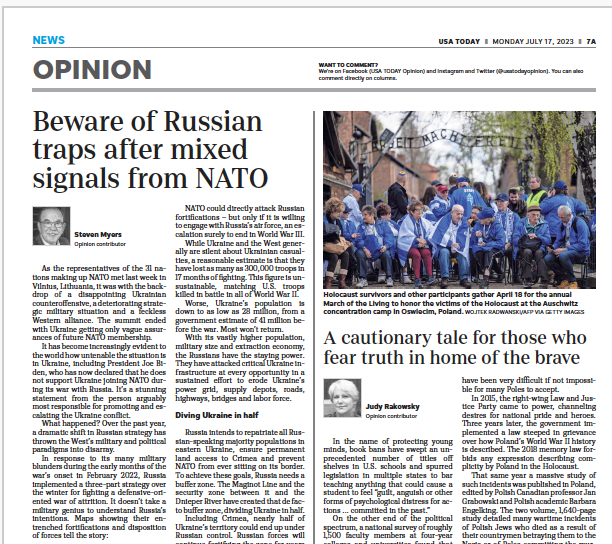As the representatives of the 31 member nations making up NATO met this week in Vilnius, Lithuania, it was with the backdrop of a disappointing Ukrainian June counteroffensive, a deteriorating strategic military situation, and a feckless Western political alliance. It has become increasingly evident to the world how untenable the situation in Ukraine is, including Joe Biden!
Biden has now declared that he does not support Ukraine joining NATO during its present war with Russia. A stunning statement from the one person arguably most responsible for promoting and escalating the Ukraine conflict in the first place. What happened? Over the last year, a dramatic shift in Russian strategy has thrown the West’s military and political paradigms into disarray.
In response to their many military blunders during the early months of the war’s onset last year, Russia implemented a new three-part strategy over the winter for fighting a defensive-oriented war of attrition. It doesn’t take a military genius to understand Russia’s intentions. Maps showing their entrenched fortifications and disposition of forces tell the story:
1. Stall Ukrainian Attacks — The Russians have created a 900-mile north-to-south “Maginot Line,” reminiscent of the French entrenched fortifications and layered defenses constructed on their border with Germany after the First World War. The Russian version has extensive artillery, rocket emplacements, surface-to-air missiles, and other weapons. They’ve created a “security zone” between these fortifications and the Dnieper River to the West, with endless mines, tank traps, and other obstacles. They’ve also significantly improved their overhead reconnaissance and surveillance capability. The Russian defenses have effectively stalled every Ukrainian attack made thus far.
Confronted with these defensive obstacles, it doesn’t matter what kind of or how many tanks Britain, Germany, Poland, and the U.S. give Ukraine. The Russians will target and destroy anything moving through the security zone. For anything reaching the Maginot Line, then what? Can any make it back? They cannot go forward without their support vehicles carrying fuel and ammunition. The further east they venture, the easier they are to target.
Zelenskyy has only two bad options: Commit forces to futile attacks, which cost significant material and troops. Or don’t attack, which creates increasing political pressure for not showing results for the $200+ Billion of U.S. and European investment. Either option supports the Russian slog intended to weaken Ukraine and the West.
A concentrated air-to-ground attack strategy could make a difference. Ukraine doesn’t have it. Sending a few F-16s wouldn’t begin to make a dent. NATO could directly attack the Russian fortifications. But only if it is willing to engage with Russia’s air force, an enormous escalation surely to end in World War III.
2. Attrition Greatly Favors Russia — While the Ukrainians and the West generally are silent about Ukrainian casualties, a reasonable estimate is that they have lost more than 300,000 troops in some sixteen months of fighting. This horrific figure is unsustainable, matching all U.S. military killed in World War II. But at four times the casualty rate. Worse, Ukraine’s population is down to some 20 million from about 36 million before the war started. Most won’t return. With its vastly higher population, military size, and extraction economy, Russia has the staying power for the slog. They have attacked critical Ukraine infrastructure at every opportunity since the war began in a sustained effort to erode Ukraine’s power grid, supply depots, roads, highways, bridges, and labor force.
3. The Buffer Zone is the End Game — Russia intends to repatriate all Russian-speaking majority populations in eastern Ukraine, ensure permanent land access to Crimea, and prevent NATO from ever sitting on their border. To achieve these goals, Russia needs a buffer zone. The Maginot Line and the security zone between it and the Dnieper River have created that de facto buffer zone, dividing Ukraine in half. Russia already controls the four oblasts they demanded initially and will now never give up: Kharkiv, Luhansk, Donetsk, or Zaporijia. They partially hold Kherson and Dnipropetrovsk. They may ultimately succeed in controlling parts of Mykolaiv and Odesa before the war reaches its inevitable stalemate. Including Crimea, some 46% of Ukraine’s territory will likely end up under Russian control. They will continue fortifying the buffer zone for many years to come. They’re not going anywhere!
At this week’s meeting, NATO admitted Sweden, bringing the alliance to 32 members. But it presented only a muddled position on Ukraine. Their communique suggested that Ukraine’s future is in NATO while at the same time kicking the can down the road with “…only when certain unspecified conditions are met.” They offered Ukraine the consolation prize of another financial aid package. Zelenkyy is, of course, infuriated and embarrassed. He’s been played, and he knows it.
This war cannot continue. Stories have begun appearing in the media about the need for some kind of compromise. One exceptionally provocative idea suggested mirrors West Germany’s entry into NATO and East Germany’s entry into the Warsaw Pact in 1955.
No apologist for Putin; I was a warrior with a first-row seat during the last Cold War, stationed on the border of the intersection of East Germany, Czechoslovakia, and West Germany in 1967 and 1968. Seeing the Iron Curtain up close and personal on a daily basis was unforgettable and sobering.
Whatever form compromise ultimately takes, the deliberate creation of this new and unnecessary Cold War will last indefinitely, cost the West dearly, and create long-term global alliances unfriendly to our geopolitical and economic interests. The inevitable tragic outcome for Ukraine will be more of what I saw during the last Cold War and much worse. And all of it results from a failure of imagination and uncompromising hubris.

